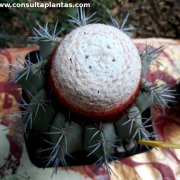Care of the cactus Melocactus azureus or Melocactus krainzianus |
|
The genus Melocactus, family Cactaceae, comprises 40 species of cacti native to Mexico, Cuba, Central and South America. Some species are: Melocactus azureus, Melocactus curvispinus, Melocactus oreas, Melocactus conoideus, Melocactus intortus, Melocactus intortus, Melocactus bahiensis, Melocactus deinacanthus, Melocactus schatzlii, Melocactus peruvianus, Melocactus ernestii, Melocactus matanzanus. Scientific synonyms: Melocactus krainzianus. This species is native to Central and northern Bahia, Brazil. They are cacti with a spherical body and a greyish or bluish green color that reach 50 cm (19.68") in height. They have 9-10 triangular ribs, 1-4 radial spines, and 7-11 radial spines. The flowers can be magenta or pink in color and appear in a woolly area (white or reddish) on the top of the plant called cephalium. They do not bloom until they are adults and have formed the cephalium. They produce 2 cm (0.78") long fruits. Melocactus krainzianusis not easy to grow because it's more delicate than most; It's used in pots to be able to move them indoors or greenhouses in winter. Melocactus azureus grows in full sun exposure and in hot climates; if the summer is very hot they appreciate a semi-shaded exposure. It does not resist temperatures below 18 ºC (64.4 ºF). The soil can be a mixture, in equal parts, of pebbles, garden substrate and coarse sand or a commercial cactus substrate with 20% well washed coarse sand. Water sparingly in spring and summer at the rate of once a month, every month and a half in autumn and do not water in winter. Fertilize with mineral fertilizer once in spring and again in summer. Melocactus azureus does not need pruning. Sometimes it can suffers attacks of mealybugs; the main danger is excess humidity. Melocactus krainzianus propagates from seeds sown in sandy substrate at 20-24 °C (68-71 ºF). |
Images of the cactus Melocactus azureus or Melocactus krainzianus |
Find plants
Melocactus azureus or Melocactus krainzianus | Care and Growing
© 2026 FavThemes



